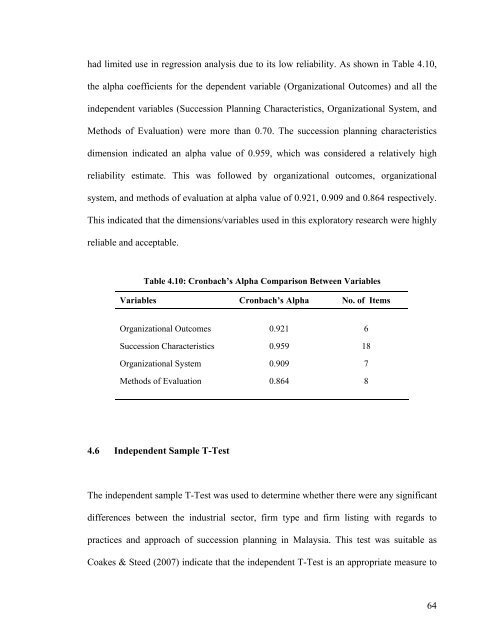CHAPTER 1: INTRODUCTION 1.0 Chapter Overview - DSpace@UM
CHAPTER 1: INTRODUCTION 1.0 Chapter Overview - DSpace@UM
CHAPTER 1: INTRODUCTION 1.0 Chapter Overview - DSpace@UM
Create successful ePaper yourself
Turn your PDF publications into a flip-book with our unique Google optimized e-Paper software.
had limited use in regression analysis due to its low reliability. As shown in Table 4.10,the alpha coefficients for the dependent variable (Organizational Outcomes) and all theindependent variables (Succession Planning Characteristics, Organizational System, andMethods of Evaluation) were more than 0.70. The succession planning characteristicsdimension indicated an alpha value of 0.959, which was considered a relatively highreliability estimate. This was followed by organizational outcomes, organizationalsystem, and methods of evaluation at alpha value of 0.921, 0.909 and 0.864 respectively.This indicated that the dimensions/variables used in this exploratory research were highlyreliable and acceptable.Table 4.10: Cronbach’s Alpha Comparison Between VariablesVariables Cronbach’s Alpha No. of ItemsOrganizational Outcomes 0.921 6Succession Characteristics 0.959 18Organizational System 0.909 7Methods of Evaluation 0.864 84.6 Independent Sample T-TestThe independent sample T-Test was used to determine whether there were any significantdifferences between the industrial sector, firm type and firm listing with regards topractices and approach of succession planning in Malaysia. This test was suitable asCoakes & Steed (2007) indicate that the independent T-Test is an appropriate measure to64
















